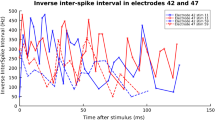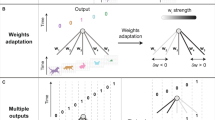Abstract
In the frame of a collaboration between Department of Information technology of the University of Milan and Stem Cells Research Institute of the DIBIT- San Raffaele, Milan, learning methods are under study following known models of the Artificial Neural Networks on human neural stem cells cultured on MEA (Multielectrode Arrays) support. The MEAs are constituted by a glass support where a set of tungsten electrodes are inserted to form a lattice structured by our group following the artificial Hopfield and Kohonen models. In such a way it is possible to electrically stimulate the neurons and to record their reaction, opening the possibility to verify in vivo learning models of the Artificial neural Networks. Neurons are stimulated with digital patterns constituted by bursts of different voltages at the input electrodes, and the electrical output generated by the neurons is analyzed with advanced methods in order to highlight organized answers by the natural neural network. The experiments performed up to now show how neurons react selectively to different patterns and show similar reactions in front of the presentation of identical or similar patterns. These results suggest the possibility of using the learning capabilities of these hybrid networks in different application fields, in particular in bionic applications.
Access this chapter
Tax calculation will be finalised at checkout
Purchases are for personal use only
Preview
Unable to display preview. Download preview PDF.
Similar content being viewed by others
References
DeMarse, T.B., Wagenaar, D.A., Potter, S.M. (2002), The neurally-controlled artificial animal: a neural-computer interface between cultured neural networks and a robotic body, SFN 2002, Orlando, Florida.
Fromherz, P., Schaden, H., Vetter, T. (1991), Neuroscience,129:77–80.
Hopfield, J.J. (1984), Neural Networks and Physical Systems with Emergent Collective Computational Abilities, Proc. Nat. Acad. Sci USA, 81.
Kohonen, T. (1990), Self-Organisation and Association Memory, Springer Verlag.
Lindner, J. F., Ditto, W. (1996), Exploring the nonlinear dynamics of a physiologically viable model neuron, AIP Conf. Proc. 375(1): 709.
Menon, V., Freeman, W.J. (1996), Spatio-temporal Correlations in Human Gamma Band Electrocorticograms, Electroenc. and Clin. Neurophys. 98, 89–102.
Pizzi, R., de Curtis, M., Dickson, C. (2002), Evidence of Chaotic Attractors in Cortical Fast Oscillations Tested by an Artificial Neural Network, in: Advances in Soft Computing, J. Kacprzyk ed., Physica Verlag.
Reger, B., Fleming, K.M., Sanguineti, V., Simon Alford, S., Mussa Ivaldi, F.A. (2000), Connecting Brains to Robots: The Development of a Hybrid System for the Study of Learning in Neural Tissues, Artificial Life VII, Portland, Oregon.
Vescovi., A.L., Parati, E.A., Gritti, A., Poulin, P., Ferrario, M., Wanke, E., Frölichsthal-Schoeller, P., Cova, L., Arcellana-Panlilio, M., Colombo, A., and Galli, R. (1999), Isolation and cloning of multipotential stem cells from the embryonic human CNS and establishment of transplantable human neural stem cell lines by epigenetic stimulation., Exp. Neurol. 156: 71–83.
Zbilut, J.P., Webber, C.L. (1992), “Embeddings and delays as derived from quantification of recurrent plots”, Phys. Lett. 171.
Author information
Authors and Affiliations
Editor information
Editors and Affiliations
Rights and permissions
Copyright information
© 2005 Springer
About this paper
Cite this paper
Pizzi1, R., Fantasia, A., Rossetti, D., Cino, G., Gelain, F., Vescovi, A. (2005). The Hopfield and Kohonen Networks: an in Vivo Test. In: Apolloni, B., Marinaro, M., Tagliaferri, R. (eds) Biological and Artificial Intelligence Environments. Springer, Dordrecht. https://doi.org/10.1007/1-4020-3432-6_24
Download citation
DOI: https://doi.org/10.1007/1-4020-3432-6_24
Publisher Name: Springer, Dordrecht
Print ISBN: 978-1-4020-3431-2
Online ISBN: 978-1-4020-3432-9
eBook Packages: Computer ScienceComputer Science (R0)




